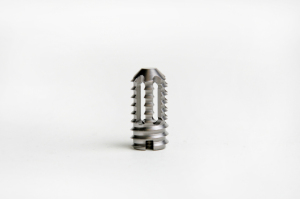by
Brendon Nafziger, DOTmed News Associate Editor | September 01, 2009

Bullet-shaped device helps
vertebrae fuse together
Sanford Clinic neurosurgeron Dr. Wilson Asfora's "Bullet Cage" received FDA approval last week to be marketed as a posterior lumbar surgery device, according to a statement issued by the clinic.
This new device is a small, bullet-shaped cage designed to help vertebrae fuse together after spinal fusion surgery, according to Sanford, a Sioux Falls, South Dakota-based medical center.
Spinal fusion surgeries are surgeries where a disc, the fibrous cushion between vertebrae that acts as a shock absorber for the bones, is removed, and the two vertebrae are allowed to grow, or fuse, together. This reduces movement and expands the spinal canal, and can relieve lower back pain in those whose spinal canals have narrowed with age, or who have a slipped or deteriorated disc.
"What's new and appealing [is] the rate of fusion is very high," Wilson Asfora, MD tells DOTmed News. According to Dr. Asfora, fusion rates for patients in his decade-long study were around 98 percent.
Dr. Asfora says his cage is a refinement on existing technology that goes back about twenty years, and allows for more precise, less traumatic surgeries.
Dr. Asfora with his invention
Traditional spinal fusion surgeries are six- to seven-hour operations in which the surgeon opens up the abdomen to insert a cage, and then turns the patient around and makes a large incision in the back, to hold the mending vertebrae in place with metallic screws, called pedicle screws.
But with the "Bullet Cage," surgeries can be done in about an hour with only a small incision in the back, and with no pedicle screws, according to Dr. Asfora.
Also, Dr. Asfora says bone fusion can be promoted with only locally harvested bone and without bone morphogenic protein. For vertebrae to fuse, they have to come into contact with exposed, living bone. Traditionally this bone comes from grafts removed from the pelvis by the surgeon. And even then, doctors have to give the patient doses of BMP, a naturally occurring protein that promotes bone growth.
But in his surgeries, Dr. Asfora just uses some of the crushed material already removed from the spine, and doesn't need BMP - something he considers a big advantage over traditional surgeries. "BMP sometimes promotes more bone growth than you want," Dr. Asfora says, "which can press the nerve," causing more pain and defeating the purpose of the surgery.
"It's always good when these devices use a minimally invasive approach," says Alan Hilibrand, MD, an orthopedic surgeon affiliated with Thomas Jefferson University Hospital in Philadelphia. "[There's] less trauma, less morbidity, less dissection of soft tissue." Dr. Hilibrand also notes that techniques like Dr. Asfora's have become increasingly widespread in his discipline.
According to the journal Spine, about 350,000 spinal fusion surgeries are performed in America each year -- a number Dr. Asfora actually thinks is too high. Dr. Asfora believes many cases that end up in the operating theater could have been solved by a few weeks of bed rest. "If you stay in bed for a month or two you'll feel better," he says. "But Americans want to be back [to work] the next day. They're not willing to spend a month or two in bed [recovering]."
Dr. Asfora says his device is not recommended for those with osteoporosis and smokers (smoking dramatically increases spine fusion failure rates by reducing blood flow to bone), although some smokers were successfully used in his study.
Source: Sanford Clinic, Spine
